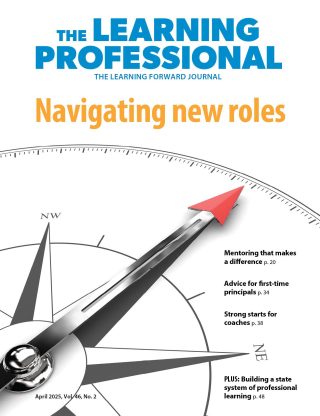IDEAS
From theory to practice
Careful planning makes the difference in implementing effective districtwide secondary programming
By Lauren Segedin
December 2018
Vol. 39 No. 6
It is midyear. A high school principal calls a teaching staff meeting. The agenda has one thing on it: a new initiative the district has mandated. Knowing few details about the program and with no implementation plan from the district, the principal is brief. In reaction to the news, one hand raises in protest, then another. A dull murmur fills the room. The principal can feel and see the hostility on teachers’ faces.
Neither the principal nor the staff should fear change, however. Without a plan or much interest from those responsible for the program, the initiative will likely limp along before fizzling out in the not-too-distant future. A new initiative will replace it, and the cycle of change (or lack thereof) will continue.
A COMPLEX UNDERTAKING
Many educators and education leaders have found implementing districtwide programming at the secondary level challenging. High schools are more organizationally complex than elementary schools (Grubb, 2010). High school teachers are deeply entrenched in subject specialties and tend to be resistant to change (Sisken, 1997).
Compared to elementary schools, high schools are larger, and student achievement and student diversity are more pronounced (Levin, 2012). While districtwide change is always hard, at the secondary level it is often even harder. Does it have to be?
A promising initiative in the Greater Essex County District School Board in Ontario, Canada, suggests that, with five key components in place, change can happen smoothly and successfully in secondary schools.
In fall 2013, the Greater Essex County District School Board was struggling to implement a program called the Specialist High Skills Major, which offers students the ability to customize their high school experience and focus on skills relevant to the world of work. Students can specialize in 19 different sectors, ranging from arts and culture to transportation.
The program requires students to complete five components. These include a bundle of eight to 10 courses, six to eight sector-specific certifications, career exploration activities in industry, and trips to post-secondary institutions, all while learning essential skills and work habits. All existing programs have undergone an extensive application process vetted by Ontario’s Ministry of Education.
The Greater Essex County District School Board has a large number of these programs compared to the provincial average. In 2013, there were 43 programs in the district’s 16 high schools, yet student enrollment in the program was average to low. Only 8% of the district’s 11th- and 12th-grade students were enrolled and, of those, only 4% completed the program — one of the worst completion rates in the province.
In four short years, that changed completely. The district gained 11 new Specialist High Skills Major programs, enrollment rose from 8% to 20%, and the program’s completion rate rose from 4% to 81%.
This change did not happen overnight, nor was it by accident. Strategic planning and focus, a modification of Michael Fullan’s (2007) framework for program implementation, and lessons learned from an evaluation of the program province-wide (Segedin, 2013) were the catalysts for this growth.
While each of the five components is significant alone, the steady growth of this program required a consistent and simultaneous focus on them all.
From this extensive research base, five key components arose to outline how to implement this high school program successfully. While Specialist High Skills Major is only one program and Greater Essex is only one school board, the foundation for this program’s implementation is strong.
Following a similar framework, other school districts may experience similar success from applying the five components:
1. Create a need.
2. Provide clarity.
3. Minimize complexity.
4. Emphasize quality.
5. Prioritize shared leadership.
CREATE A NEED
Creating a need for any program in education is important. If educators see a clear need between a program and its school or students, they are more likely to support it (Fullan, 2007). In the Greater Essex County District School Board, it was easy to explain the need for the program.
The Specialist High Skills Major is a labor market-based career program, and this school district is in an area that had the highest unemployment rate in the country for over seven years. Adult unemployment was 16%, and youth unemployment was 25%.
At a time when employment was difficult to find, the program offered free work-related training and certifications, sector-specific knowledge, and work experience, regardless of whether students were headed to university, vocational college, apprenticeships, or the workplace after they graduated.
Specialist High Skills Major is also a heavily resourced program. Enrollment in the program means more money flowing into schools. When the district coordinator linked the program with the region’s economic profile, educators, students, and parents could see the relevance of the program to their lives and community. The program became an easy sell to everyone involved, and, in turn, enrollment rose.
PROVIDE CLARITY
When goals are unclear, a policy may be adopted in principle, but the implementation will likely fall short of the policymakers’ intentions. At the Greater Essex County District School Board, program completion was initially poor because educators were not aware of all the requirements and teachers did not have the resources to meet the ones they did understand. For example, students are required to gain six to eight sector-specific certifications, but many teachers did not have contact information for job-specific training in different sectors.
As leaders in Greater Essex learned, clearly outlining a goal and providing flexible ways to implement it can improve implementation (Bascia & Hargreaves, 2000; Datnow & Park, 2009). First, the district-level program coordinator simplified the 300-page implementation binder from the Ministry of Education. Educators could also choose to participate in half-day professional learning sessions.
The abridged binder and professional learning session made the requirements clear and created more centrally organized teacher resources. As a result, program completion increased.
MINIMIZE COMPLEXITY
According to Michael Fullan (2007), three factors make a policy complex: new materials, new teaching, and new beliefs. If an individual only has to adjust his or her thinking in one way (e.g. new materials), change can be relatively easy.
For an individual who needs to adjust in all three components, however, change is harder (Fullan, 2007). It is helpful to figure out where and why a policy is complex for its users in order to minimize complexity and tailor support.
In the Specialist High Skills Major program, one component seemed particularly complex for teachers: curriculum delivery in core subject areas (e.g. math, English, science) while integrating sector-specific knowledge into assignments (such as writing an English essay). For some teachers and some subject areas, this task was relatively easy, but for others, it was challenging.
To minimize complexity at the Greater Essex County District School Board, the program coordinator hosted lunchtime learning sessions for teachers. Sharing the need for the program elicited teacher support. Offering an implementation plan and resources, including lesson plans, created ease in implementing program requirements. Providing free lunch enticed them to attend.
Almost every invited teacher attended the meetings and, as a result, the complexity level decreased.
EMPHASIZE QUALITY
For successful program implementation to occur, the program itself must have a high level of quality. Quality arises from front-end capacity building or the support a district provides. This can include additional funding, targeted and sustained professional learning, high-quality resources, and networks of teachers across schools. Providing relevant educational opportunities that motivate and engage students also speaks to the quality of a program (Fullan, 2007; Levin, 2008).
The Greater Essex County District School Board’s high-quality resources and teacher professional learning supported implementation of its Specialist High Skills Major program. To increase the program’s quality, the district developed teacher networks.
One or more teachers led each of the 43 school-based programs. This created a network of teacher leaders who supported one another across the system while eliciting support from administration, teachers, and students within their own schools.
While teacher support was important, students were included in the vision for the program’s quality, too. Providing students with relevant and interesting training and field trip opportunities increased the program’s quality, which boosted student attendance at events, leading to more students completing the program’s requirements.
PRIORITIZE SHARED LEADERSHIP
Leadership is essential and enables all of the components describes previously. Strong leadership includes providing direction, setting high but attainable goals, and sharing roles and responsibilities with teachers (Leithwood, Louis, Anderson, & Wahlstrom, 2005).
In the Greater Essex County District School Board, district leadership set the direction by clearly outlining the program’s requirements and providing group and individual teacher support to meet them. The program’s success directly correlated to teacher leaders sharing the program’s requirements.
For example, transparently co-planning the use of the program’s extensive finances and including teachers’ ideas in the program’s vision created a practical and collaborative team approach to meeting the program’s overarching goals. This team approach was necessary for teachers to be willing to invest their time and effort into a goal.
SLOW DOWN AND PLAN CAREFULLY
While each of the five components is significant alone, the steady growth of this program required a consistent and simultaneous focus on them all. This may seem daunting at first. However, implementation in education is often rushed. It does not have to be.
Slowing down to consider the research and align it with a specific program in a specific geographical region makes sense. A few months of detailed and careful planning is what it takes initially. After that, all that is required is frequent monitoring, providing support, and tweaking the plan when needed.
While this may seem a lot to ask of underresourced school boards, consider the potential waste of money, time, and negative staff and student morale that results from a failed initiative.
Change is inevitable. School districts implement change every year. No matter what the change, implementation is typically a challenge. It often fails, but success is possible with thoughtful, research-based planning and consistent execution.
By creating a need, providing clarity, minimizing complexity, emphasizing quality, and prioritizing shared leadership, successful program implementation is possible. It is a lot of work, but the benefits to staff and students demonstrate that it is time well spent.
Lauren Segedin (Lauren.Segedin@publicboard.ca) is a secondary literacy coach and former coordinator of the Specialist High Skills Major program at the Greater Essex County District School Board in Ontario, Canada.
References
Bascia, N. & Hargreaves, A. (2000). Teaching and leading on the sharp edge of change. In N. Bascia & A. Hargreaves (Eds.), The sharp edge of educational change: Teaching, leading and the realities of reform (pp. 3-26). New York, NY: Routledge.
Datnow, A. & Park, V. (2009). Conceptualizing policy implementation: Large-scale reform in an era of complexity. In G. Sykes & D. Plank (Eds.), Handbook of education policy research (pp. 348-361). Washington, DC: American Educational Research Association.
Fullan, M. (2007). The new meaning of educational change (4th ed.). New York, NY: Teachers College Press.
Grubb, N. (2010). Leadership challenges in high schools: Multiple pathways to success. Boulder, CO: Paradigm Press.
Leithwood, K., Louis, K.S., Anderson, S., & Wahlstrom, K. (2005). How leadership influences student learning. New York, NY: The Wallace Foundation.
Levin, B. (2008). How to change 5000 schools. Cambridge, MA: Harvard Education Press.
Levin, B. (2012). More high school graduates. Thousand Oaks, CA: Corwin Press.
Segedin, L. (2013). Understanding how the implementation of the Specialist High Skills Majors programs in Ontario schools contributes to student outcomes (Unpublished doctoral dissertation). OISE, University of Toronto, Toronto, Canada.
Siskin, L. (1997). The challenge of leadership in comprehensive high schools: School vision and departmental divisions. Educational Administration Quarterly, 33(1), 604-623.
Recent Issues
LEARNING DESIGNS
February 2025
How we learn influences what we learn. This issue shares essential...
BUILDING BRIDGES
December 2024
Students benefit when educators bridge the continuum of professional...
CURRICULUM-BASED PROFESSIONAL LEARNING
October 2024
High-quality curriculum requires skilled educators to put it into...
LEARNING TO PIVOT
August 2024
Sometimes new information and situations call for major change. This issue...












